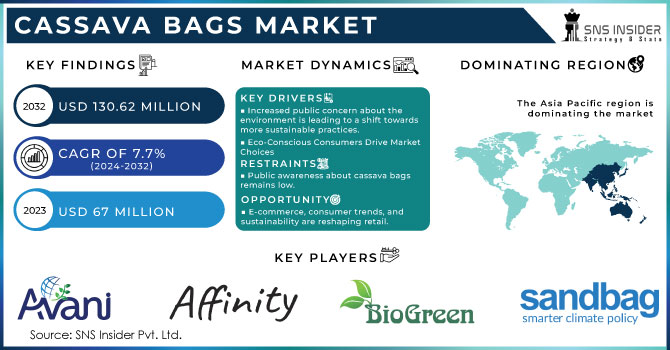The Global Cassava Bags Market is experiencing a robust surge driven by increasing environmental awareness, the need for sustainable packaging solutions, and growing demand across various industries. According to a comprehensive market research report, the cassava bags market, valued at USD 67 million in 2023, is projected to reach an impressive USD 130.62 million by 2032, exhibiting a compound annual growth rate (CAGR) of 7.7% during the forecast period of 2024-2032.
This substantial growth trajectory is fueled by a confluence of factors, including the push for eco-friendly alternatives to traditional plastic bags, the increasing regulations on plastic usage, and the versatile applications of cassava bags in multiple sectors.

Download Free Sample Report: https://www.snsinsider.com/sample-request/4280
The Need for Sustainable Packaging Solutions
In today’s environmentally conscious society, there is a significant push towards reducing plastic waste and minimizing the environmental impact of packaging materials. Cassava bags, derived from the cassava root, present a biodegradable and compostable alternative to conventional plastic bags. These eco-friendly bags decompose naturally, reducing the burden on landfills and mitigating pollution in oceans and other natural habitats.
Cassava bags are gaining traction as a sustainable solution due to their low environmental footprint and the ability to biodegrade within months without leaving harmful residues. This shift towards sustainable packaging solutions is propelling the demand for cassava bags in various industries, including food and beverages, retail, and animal feed.
Market Segmentation by Type, Category, and End User
The cassava bags market is segmented based on type, category, and end-user application, providing a comprehensive overview of the diverse market landscape.
By Type:
- Grip-Hole
- T-Shirt
- Garbage
By Category:
- Organic
- Conventional
By End User:
- Food & Beverages
- Animal Feed
Regional Insights: North America Leads, Asia-Pacific Emerges
North America currently dominates the global cassava bags market, driven by a well-established culture of environmental consciousness, stringent regulations on plastic usage, and the presence of leading manufacturers. The region’s commitment to sustainable practices and the growing adoption of eco-friendly packaging solutions contribute to its market leadership.
However, the Asia-Pacific region is expected to witness the highest growth rate during the forecast period, fueled by rapid industrialization, increasing awareness of environmental issues, and supportive government initiatives. Countries such as China, India, and Japan are at the forefront of adopting sustainable packaging solutions, driving the demand for cassava bags in the region.
Key Players and Strategic Initiatives
The cassava bags market is highly competitive, with several key players vying for market share through strategic acquisitions, partnerships, and innovative product offerings. Prominent players in the market include
- Avani Eco Affinity Supply Co
- Biopac India Co. Ltd
- Envigreen Biotech India Pvt. Ltd
- Affinity Supply Co
- Biogreen Bags Co. Ltd
- SainBag No Plastic International Pty Ltd
- SandBag
- IMillionotplasticbag
- Baolai Packaging Co., Ltd
- Urban Plastik Indonesia
- Baolai Packaging Co., Ltd
- Tipa
- Henan Baolai Packaging Co., Ltd
These companies are actively investing in research and development to enhance the quality and performance of cassava bags, exploring new applications, and expanding their market presence. Strategic collaborations with retailers, food service providers, and government bodies are also driving the market forward.
For instance, in 2022, Avani Eco entered into a partnership with a major supermarket chain to supply cassava bags for their grocery stores, significantly boosting the visibility and adoption of cassava bags among consumers.
Regulatory Landscape and Challenges
While the cassava bags market presents immense growth opportunities, it is not without challenges. Ensuring the consistent quality of cassava bags, managing production costs, and addressing supply chain disruptions are key concerns for manufacturers. Additionally, raising consumer awareness about the benefits of cassava bags and overcoming resistance to change from traditional plastic bags are ongoing challenges that require concerted efforts.
The regulatory landscape also plays a crucial role in shaping the market dynamics. Governments worldwide are implementing policies to reduce plastic waste and promote sustainable packaging solutions. Compliance with these regulations and adherence to industry standards are essential for market players to thrive in this evolving landscape.
The Future of Cassava Bags: Innovations and Sustainability
As the cassava bags market continues to evolve, several key trends are expected to shape its future trajectory. Innovations in production techniques, enhanced durability, and cost-efficiency are areas of focus for manufacturers. The integration of cassava bags into various applications beyond retail and food packaging, such as agricultural uses and medical packaging, will further expand their market potential.
Moreover, the emphasis on sustainability and environmental responsibility will drive continuous improvements in the cassava bags industry. Companies are exploring ways to enhance the biodegradability of cassava bags, reduce their carbon footprint, and develop closed-loop recycling systems.
Conclusion
The cassava bags market presents a compelling growth opportunity driven by the increasing demand for sustainable packaging solutions, the rising awareness of environmental issues, and supportive regulatory frameworks. As the market continues to expand, key players are poised to capitalize on emerging trends, leveraging technological advancements and introducing innovative solutions that cater to the evolving needs of industries and consumers worldwide.
Other Trending Reports
Aseptic Paper Packaging Industry
Antimicrobial Packaging Industry
About Us:
SNS Insider is one of the leading Market Size research and consulting agencies that dominates the Market Size research industry globally. Our company’s aim is to give clients the knowledge they require in order to function in changing circumstances. In order to give you current, accurate Market Size data, consumer insights, and opinions so that you can make decisions with confidence, we employ a variety of techniques, including surveys, video talks, and focus groups around the world.

